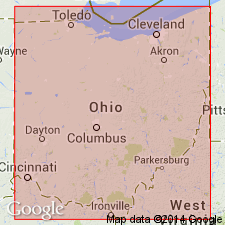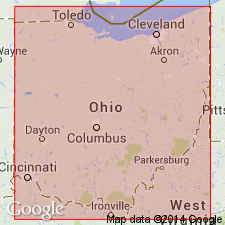
- Usage in publication:
-
- Cincinnati group
- Modifications:
-
- Revised
- AAPG geologic province:
-
- Cincinnati arch
Summary:
The Geological Survey of Ohio recognizes the Cincinnati group proposed by Meek and Worthen (1865), but at this time retains it as an informal term. The unit will be formally reinstated as a lithostratigraphic term after revision of its lower boundary and minor lithologic redescription of its units are completed. The ten formations included in the group are the (ascending) Clays Ferry Formation, the Kope Formation, the Fairview Formation, the Miamitown Shale, the Grant Lake Limestone, the Arnheim Formation, the Waynesville Formation, the Liberty Formation, the Whitewater Formation, and the Drakes Formation. Six members have been identified in the course of field mapping: the Point Pleasant Tongue of the Clays Ferry, the informal Bellevue, Corryville, Mount Auburn, and Straight Creek members of the Grant Lake Limestone, and the Preachersville Member of the Drakes Formation. The Backbone Creek and Elk Creek beds are recognized as excellent stratigraphic marker beds.
Source: GNU records (USGS DDS-6; Reston GNULEX).

- Usage in publication:
-
- Cincinnati group
- Modifications:
-
- Overview
- AAPG geologic province:
-
- Cincinnati arch
Summary:
In northwestern OH, overlies the Trenton Limestone and the Point Pleasant Formation. In the subsurface of the report area the unit is undifferentiated, though the basal Kope Formation can be identified. Preliminary correlations indicate a great deal of intertonguing and many facies changes above the Kope. Basal portion of the Cincinnati is composed of light- to dark-gray shales and silty shales grading upward into light-gray to green calcareous shales intermixed and interlayered with fine- to medium-crystalline fossiliferous limestones and dolomites. Group thickens from less than 700 ft in extreme western OH to approximately 950 ft on the eastern edge of the study area.
Source: GNU records (USGS DDS-6; Reston GNULEX).
For more information, please contact Nancy Stamm, Geologic Names Committee Secretary.
Asterisk (*) indicates published by U.S. Geological Survey authors.
"No current usage" (†) implies that a name has been abandoned or has fallen into disuse. Former usage and, if known, replacement name given in parentheses ( ).
Slash (/) indicates name conflicts with nomenclatural guidelines (CSN, 1933; ACSN, 1961, 1970; NACSN, 1983, 2005, 2021). May be explained within brackets ([ ]).

